Unit 7. Automobile Service
Section A. Automobile Service Station
I. Scan the text “Automobile Service Station” to find answers to these questions.
- Why are automobile service stations in great demand nowadays?
- What services do service stations offer?
Automobile Service Station
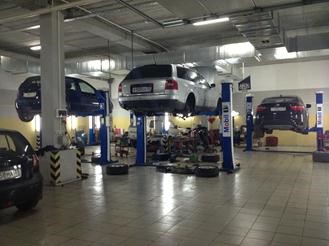
There is good demand for automobile service stations due to increase in the number of vehicles day to day.
Automobile service stations offer services for a variety of vehicles: cars, vans, light and medium duty trucks, busses and road trains. Automobile stations perform brakes and air conditioning repairs, engine diagnostic, electrical, steering and suspension repair as well as major component replacement such as engines, transmissions and drive train components. It also provides wheel alignment and frame repair or replacement service on all vehicles, including cars, trucks, trailers and oversized vehicles. Мany auto shops offer free brake inspection services. They start with the pads, check the response time on brakes; also check the brake fluid level to see if it's maintained to the correct amount.
All manufacturers have schedules of recommended services for each of their cars.
Engine: Drive Train:
- Check engine light ▪ Transmission
- Heating and Cooling Repairs ▪
Wheel Bearings
- Air Conditioning ▪ Differential
- Belts and Hoses ▪ Steering System
- Timing Belt replacement ▪ Transmission
- Exhaust System ▪ Bearing Lube
- Emission System checks ▪ Steering
Fluid
Coolant flushing
Suspension: Electrical:
- Brakes ▪ Battery
- ABS System ▪ Alternator
- Shocks ▪ Starter
- Struts ▪ Charging System
- Wheel Bearings ▪Lights
- Alignment ▪ Instruments
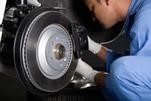
This list of services may vary between make and model and can also depend on the condition of a car.
- Change engine oil
- Change engine oil filter
- Check / Fill brake fluid
- Check brake fluid condition
- Check / fill / test clutch fluid level
- Check / fill / test coolant /radiator fluid level
 Visual check of cooling system hoses
Visual check of cooling system hoses
- Check / Fill power steering fluid
- Check / Fill battery fluid level
- Test battery condition
- Check / Fill windscreen washer fluid
- Check / Adjust gearbox / transmission fluid level
- Check / Adjust tyre pressure and condition
- Check / Test side / indicator / brake / number plate / reverse lights
- Check / Adjust headlights
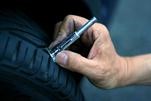 Visual Inspection exhaust system
Visual Inspection exhaust system
- Check fuel filter
- Visual Check spark plugs
- Check / Measure tyre condition
- Check charging system output
- Test exhaust gas analysis / emission test
 Replace up to 3 standard wiper blades
Replace up to 3 standard wiper blades
- Complete diagnostic code check
- Road test up to 50km/hr
- Visual check / adjust brakes
- Rotate tyres
- Visual check wheel cylinders
- Visual check suspension
- Visual search for replacement date cam belt
Notes:
coolant, n.–охлаждающая жидкость
flushing, n.–заливка
suspension, n.–подвеска
alternator, n.–генератор переменного тока
charging, n. – подзарядка
strut, n.– стойка
wheel bearings, n.–подшипники колеса
bearing lube, n. – смазка подшипников
fluid, n. – жидкость
Section B. Automotive Service Technicians
I. Scan the text “Automotive Service Technicians” to find answers to these questions.
- What kind of jobs do automotive service technicians typically do?
- What components do service technicians work?
- Why must service technicians be familiar with electronic systems?
- What vehicles do automotive service technicians work on?
Automotive Service Technicians
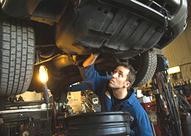
Automotive service technicians inspect, diagnose, repair and service mechanical, electrical and electronic systems and components of cars and light trucks. In repairing cars, their main role is to diagnose the problem accurately and quickly. They often have to quote prices for their customers before starting work or after partial dis-assembly for inspection. The mechanic uses both electronic means of gathering data as well as their senses. Automotive service technicians and mechanics typically do the following:
- Test parts and systems to ensure that they are working properly
- Identify mechanical problems, often by using computerized diagnostic equipment
- Follow checklists to ensure that all critical parts are examined
- Test and lubricate the vehicle’s engine and other major components
- Perform basic maintenance, including oil changes, tune-ups, and tyre rotations
- Repair or replace worn parts, such as brake pads and wheel bearings
- Disassemble and reassemble parts
- Use testing equipment to ensure that repairs and maintenance are effective
- Explain to clients their automotive problems and the repairs done on their vehicles
Service technicians work on traditional mechanical components, such as engines, transmissions, belts, and hoses. However, they must also be familiar with a growing number of electronic systems. Braking, transmission, and steering systems, for example, are controlled primarily by computers and electronic components.
Other integrated electronic systems, such as accident-avoidance sensors, are becoming common as well. In addition, a growing number of technicians are required to work on vehicles that run on alternative fuels, such as ethanol and electricity.
Notes:
checklists, n.–контрольная таблица
wheel bearing, n. – подшипник колеса
ensure, v. – гарантировать
disassemble, v. – демонтировать
reassemble, v. – снова собирать
accident-avoidance sensor, n.–датчик предупреждения аварии
to require, v.–нуждаться, требовать
II. Read the text “Automotive Tools and Instruments” and say what tools are used by automotive service technicians.
Automotive Tools and Instruments
Service technicians use a variety of tools in their work. They use power tools, such as pneumatic wrenches to remove bolts quickly; machine tools like lathes and grinding machines to rebuild brakes; welding and flame-cutting equipment to remove and repair exhaust systems; and jacks and hoiststo lift cars and engines.
They also use common hand tools, such as screwdrivers, pliers, and spanners to work on small parts and in hard-to-reach places.
Technicians usually provide their own hand tools and many experienced workers have thousands of dollars invested in them. Employers furnish engine analyzers, and other diagnostic equipment. Some common tools and automotive equipment are shown below.
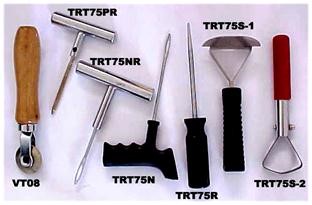
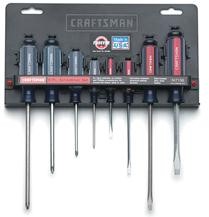
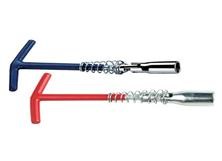
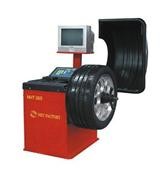
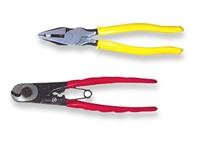
Tyre Repair Tools (TRT)
Cut Pliers Spark-Plug-Spanners Digital Wheel Balancer
Notes:
power tool, n. – инструмент с электроприводом
exhaust systems, n. – системы выпуска двигателя
grinding machine, n.–шлифовальный станок
wrench / spanner, n. – гаечный ключ
machine tool, n.–станок
lathe, n.–токарный станок
rebuild, v.– восстановить
flame-cutting, n. – газопламенная резка
welding, n.–сварка
jack, n. – домкрат
hoist, n.–подъемник
screwdriver, n.– отвертка
pliers, n.–плоскогубцы
III. Translate the text “Specialization in Types of Repairs”. Use dictionary if necessary.
Automotive Tools and Instruments
Automotive service technicians in large shops often specialize in certain types of repairs.
Transmission technicians and rebuilderswork on gear trains, hydraulic pumps, and other parts of transmissions. Extensive knowledge of computer controls, the ability to diagnose electrical and hydraulic problems and other specialized skills are needed to work on these complex components, which employ some of the most sophisticated technology used in vehicles.
Tune-up techniciansadjust ignition timing and valves and adjust or replace spark plugs and other parts to ensure efficient engine performance. They often use electronic testing equipment to isolate and adjust malfunctions in the fuel, ignition and emissions control systems.
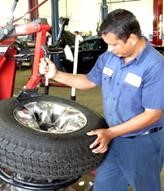
Automotive air-conditioning repairersinstall and repair air-conditioners and service their components, such as compressors, condensers, and controls.
Front-end mechanicsalign and balance wheels and repair the steering mechanisms and suspension systems. They frequently use special alignment equipment and wheel-balancing machines.
Brake repairersadjust brakes, replace brake linings and pads, and make other repairs on brake systems. Some technicians specialize in both brake and front-end work.
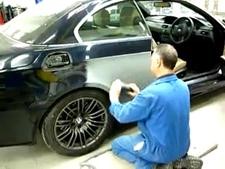
Automotive body repairers straighten bent bodies, remove dents, and replace crumpled parts that cannot be fixed. They repair all types of vehicles, but most work on cars and small trucks. They can work alone, with only general direction from supervisors, or as specialists on a repair team. In some shops, helpers or apprentices assist experienced repairers.
Body repairers may also repair or replace the plastic body parts that are widely used on new vehicles. They remove damaged panels and identify the type and properties of the plastic used. A few body repairers specialize in fixing fiberglass car bodies.
Notes:
tune-up, n. – наладка, регулировка properties, n.– свойства
body repairs, n.–кузовные работы fiberglass, n. – стекловолокно
dented panel, n. – вмятины на панели gear train, n. – зубчатая передача
remove dents, v. – убирать вмятины supervisor, n.–зд. мастер
adjust ignition timing, v.– регулировать момент зажигания
crumpled parts, n.–деформированные детали
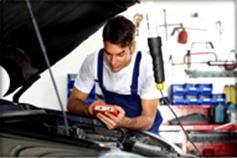
When mechanical or electrical troubles occur, technicians first get a description of the problem from the owner or, in a large shop, from the repair service estimatoror service advisor who wrote the repair order. To locate the problem, technicians use a diagnostic approach. First, they test to see whether components and systems are secure and working properly. Then, they isolate the components or systems that might be the causeof the problem. For example, if an air-conditioner malfunctions, the technician might check for a simple problem, such as a low coolant level, or a more complex issue, such as a bad drive train connection that has shorted out the air conditioner.
As part of their investigation, technicians may test drive the vehicle or use a variety of testing equipment, including onboard and diagnostic computers. Accuracy and efficiency are critical in diagnosing and repairing vehicles, as parts are increasingly expensive, and timely repairs allow shops to take on more business.
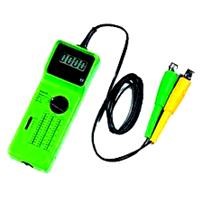
Notes:
estimator, n.–оценщик
advisor, n. – консультант
repair order, n.– ремонтный заказ-наряд
diagnostic approach, n. – диагностический подход
secure, adj. – надежный
cause, n.–причина
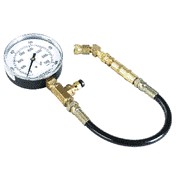
malfunction, v.–работать неисправно
coolant level, n. – уровень охлаждающей жидкости
drive-train, n. – зубчатая передача
investigation, n.–обследование, изучение причин
salvageable, adj. – для повторного использования
accuracy, n.–точность
timely repairs, n.–выполненный в срок ремонт
V. Read the text “Computer Diagnostic Testing” and say what role the On-Board Diagnostics plays in modern cars.
Computer Diagnostic Testing
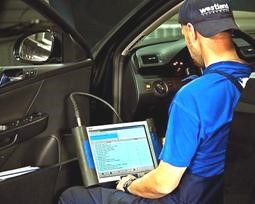
Computers are also commonplace in modern repair shops. Service technicians compare the readoutsfrom computerized diagnostic testing devices with benchmarked standards given by the manufacturer. Deviations outside of acceptable levels tell the technician to investigate that part of the vehicle more closely.
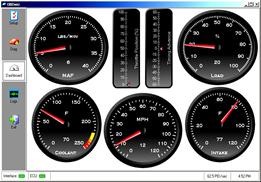
The On-Board Diagnostics, or the OBD, in an automotive context, is a general term referring to a vehicle's self-diagnostic. The OBD systems inform owners or repair technicians about state of health for various vehicle sub-systems. Modern OBD systems use a standardized digital communications port to provide real time data in addition to a standardized series of Diagnostic Trouble Codes, or DTCs, which allow service technicians rapidly identify and remedy malfunctions within the vehicle.
High technology tools are needed to fix the computer equipment that operates everything from the engine to the radio in many cars. In fact, today, most automotive systems, such as the braking, transmission, and steering systems are controlled primarily by computers.Additionally, luxury vehicles often have some integrated global positioning systems, accident-avoidance systems, and other new features with which technicians will need to become familiar.
Notes:
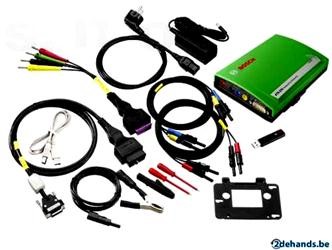
readout, n.–показание прибора
deviation, n.–отклонение
investigate, v. – изучить
On-Board Diagnostics, n. – бортовая (встроенная) диагностика
trouble code, n. – код неисправности
remedy, v. – исправлять
malfunction, n.– неисправность
benchmarked, n. – сопоставительные испытания
Morozova О.N., Ilina I.Y.Тамбов2015